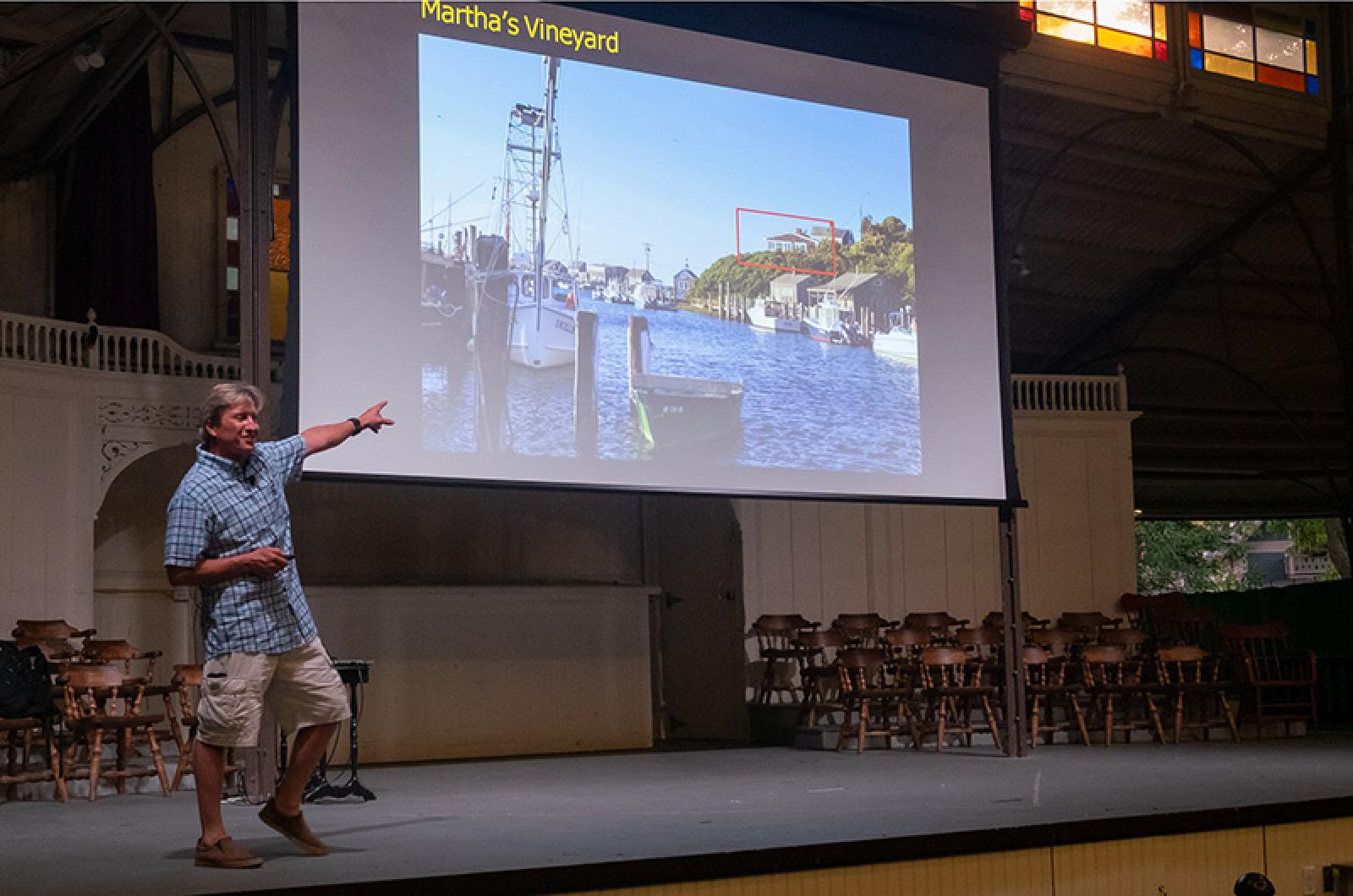An attentive, all-ages audience of about 200 came to the Oak Bluffs Tabernacle Thursday night to hear state shark expert Gregory Skomal give a multimedia talk called Seeing Deeper Into the World of the Great White Shark.
A marine biologist with the Massachusetts Division of Marine Fisheries, Mr. Skomal has gained a national audience with his Shark Week appearances on the Discovery Channel. But Martha’s Vineyard can claim him for her own: he worked on the Island for 23 years, starting in 1987.
And he had some good news for Island swimmers and fishermen Thursday. While great white sharks are moving into the Cape and Islands area, they don’t seem that interested in hanging around Vineyard beaches. Most of the great white sharks are frequenting the outer Cape, Mr. Skomal said, displaying maps derived from tagged-shark data. That area is on its way to joining the world’s great white shark hotspots, he said, because the seal population — a favored prey of the great white — has been rebounding since it became protected by law.
The Vineyard’s State Beach, he told the audience, is “not an area I’m the least bit worried about,” because great white sharks don’t generally come through Nantucket Sound until the autumn.

At South Beach, however, “I can’t guarantee your safety,” Mr. Skomal said, although the only great white sharks that have been spotted there appeared to be on the move and not on the hunt.
“I’m not particularly concerned about the south side of the Vineyard,” he said.
Mr. Skomal showed both slides and videos during his presentation, including photos taken from a low-flying plane by spotter pilot Wayne Davis. The audience shared a collective shudder at one shot showing a large shark just beneath the surface of the water near an oblivious sailboarder.
But that was nothing compared to the video clip from a camera-equipped underwater drone that captured an onrushing shark, opening its jaws wide. The footage ends abruptly after a nightmarish close-up of its great white tongue.
“We’ve lost three cameras that way,” Mr. Skomal said.
Studying sharks and their behavior has been Mr. Skomal’s vocation since he was just out of high school and saw the new movie Jaws. He was already a fan of Jacques Cousteau, the French sea explorer whose television program ran for 10 years beginning in 1966. But the marine biologist played by Richard Dreyfuss in the Steven Spielberg film made a lifelong impression on the teenager.
“I wanted to be Matt Hooper,” he told the Tabernacle crowd. “He was fascinated by sharks and I was fascinated by sharks.”

While much of his early work involved dissecting and examining dead sharks — one of the videos he showed was a time-lapse of a shark necropsy — he now spends more time tagging and tracking sharks, with nearly all of his work funded by the Atlantic White Shark Conservancy.
“At no point have I been in danger of being bitten by a shark,” Mr. Skomal said. But he has suffered frustration and disappointment.
In 2004, it should have been a dream come true when a great white shark holed up in a saltwater pond on Naushon island. Instead, “it became somewhat of a nightmare,” Mr. Skomal said.
After satellite-tagging the visitor, he waited an excruciating two weeks for it to leave the pond and go back to sea. Then, 45 minutes after the shark entered the open water, its tag malfunctioned and came off.
“The highest high of my life cratered,” Mr. Skomal said.
Following his fast-paced, hour-long talk, Mr. Skomal took questions from the audience. Asked what was the strangest thing he ever found in a shark’s stomach, he recalled dissecting a tiger shark that had swallowed five horseshoe crabs, two birds and a McDonald’s wrapper.
“It’s a species that eats almost anything,” he said.
One small child asked Mr. Skomal why he wanted become a biologist.
“Because I think the ocean’s cool,” he replied, adding “Because I love it so much I want to help it.”
At the end of the question-and-answer session, some two dozen people lined up for autographs from Mr. Skomal, the author of multiple books including The Shark Handbook.






Comments
Comment policy »